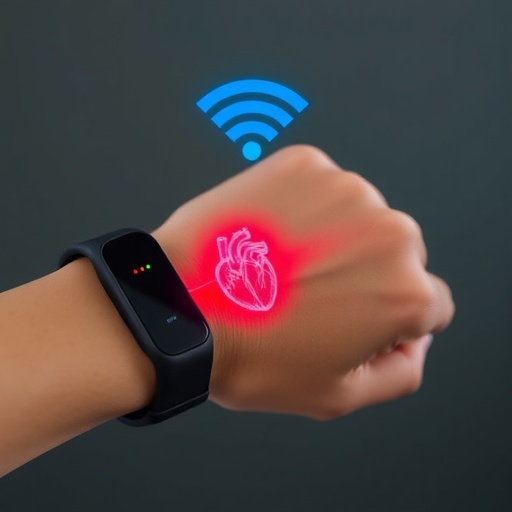A groundbreaking advancement in the realm of health monitoring technology has emerged from the University of California, Santa Cruz, where researchers have developed a novel system called Pulse-Fi. This innovative technology transforms ordinary household WiFi signals into a non-invasive method for accurate heart rate measurement. The implications of this research extend beyond convenience, offering a potential lifeline for health monitoring in environments with minimal resources.
The traditional methods for measuring heart rate typically involve either wearable devices, such as smartwatches, or more expensive hospital-grade equipment. However, the exclusive reliance on these devices can be restrictive both economically and logistically, particularly in lower-resource settings. In response to these limitations, the Pulse-Fi initiative introduces a more accessible alternative, utilizing existing WiFi infrastructure to conduct health assessments. As a result, virtually anyone could potentially conduct accurate health monitoring right from their homes.
Pulse-Fi represents not just an incremental improvement but a monumental leap in the integration of machine learning and everyday technologies. At the heart of this system lies a combination of low-cost WiFi devices and advanced signal processing algorithms. The researchers, led by Professor Katia Obraczka, along with Ph.D. student Nayan Bhatia and high school researcher Pranay Kocheta, engineered this revolutionary system to overcome the challenges posed by environmental noise and movement, which have historically plagued conventional heart rate detection methods.
By employing WiFi technology that transmits and receives radio frequency waves, the Pulse-Fi system extends its functionality beyond mere connectivity. The researchers discovered that when WiFi signals traverse through diverse objects, subtle variations occur, which are indicative of a person’s heartbeat. This realization formed the foundational principle behind Pulse-Fi, where the challenge shifted to discerning these minute changes amidst the background noise of everyday life.
During their research, the team conducted extensive testing with 118 participants, meticulously analyzing heart rates across various physical positions—standing, sitting, lying down, and even walking. The results were nothing short of extraordinary; after just five seconds of signal processing, Pulse-Fi was able to achieve clinical-level accuracy. Errors in heart rate measurement were reduced to a mere half beat per minute, with longer monitoring periods amplifying this precision. Such robust performance across a range of body positions and distances not only validates the technology but reveals its practical viability for real-world applications.
An intriguing aspect of Pulse-Fi is its low-cost operational model. Leveraging inexpensive components such as ESP32 and Raspberry Pi chips, the monetary investment required for users remains minimal—ranging from $5 to $30. This affordability is particularly significant for implementing health monitoring solutions in economically disadvantaged areas where access to sophisticated medical technology may be limited. Furthermore, the researchers anticipate that utilizing more advanced WiFi devices may yield even greater precision in heart rate detection, paving the way for commercial applications in healthcare.
One of the defining characteristics of this technology is its adaptability. In light of the research, it was found that the distance between the person being monitored and the hardware setup had virtually no effect on performance—an impressive feat that previous heart rate monitoring models struggled to achieve. The researchers’ meticulous attention to the system’s resilience against environmental noise fosters confidence in its utility across various real-world scenarios.
To facilitate the learning capabilities of their machine learning algorithm, the research team undertook the task of creating an unprecedented dataset geared specifically towards heart rate detection using WiFi signals. This initiative involved rigorous data collection methods, where they coupled the findings from the Pulse-Fi system with “ground truth” data garnered from traditional oximeters. This correlation allowed them to effectively train their neural networks to identify the unique signal changes correlated with heartbeats, thus enhancing the system’s overall accuracy.
As the potential applications of Pulse-Fi expand, the researchers are ambitiously exploring the possibility of extending the technology’s capabilities to include monitoring breathing rates. This advancement could revolutionize the identification and management of respiratory conditions such as sleep apnea, further enhancing the system’s relevance in healthcare. Preliminary results in this domain show promise, indicating that Pulse-Fi may soon offer dual monitoring capabilities essential for comprehensive health assessments.
In a world increasingly reliant on technology for health management, the Pulse-Fi project represents a significant step toward breaking down barriers between accessible health monitoring and advanced technological tools. This ambitious initiative not only emphasizes the ongoing need for innovative solutions but serves as a reminder of how convergence between computing and healthcare can create transformative opportunities for individuals and communities at large.
The potential commercialization of the Pulse-Fi technology further amplifies its significance, as it addresses the urgent need for routine health monitoring in a manner that is both economical and effective. The move toward accessible healthcare monitoring is crucial not only from a clinical perspective but also from a socio-economic standpoint, as it has the ability to uplift entire communities by providing essential health data that can inform treatment decisions and overall well-being. The collaborative efforts and innovative spirit behind the Pulse-Fi technology are likely to pave the way for a new era in health monitoring, one that is equitable, inclusive, and inherently transformative.
This revolutionary approach to health monitoring using WiFi technology underscores the unbounded potential of engineering and research in addressing real-world challenges. As researchers like those at UC Santa Cruz continue to push the boundaries of what is possible, the future of health technology promises to be more inclusive and accessible than ever before. With Pulse-Fi leading the charge, we can anticipate a world where accurate health monitoring is integral to everyday life, empowering individuals to prioritize their well-being without the constraints of traditional healthcare paradigms.
Subject of Research: Pulse-Fi Technology for Heart Rate Monitoring
Article Title: Pulse-Fi: A Low-Cost System for Accurate Heart Rate Monitoring Using Wi-Fi Channel State Information
News Publication Date: 5-Aug-2025
Web References: http://dx.doi.org/10.1109/DCOSS-IoT65416.2025.00037
References: Not available
Image Credits: Erika Cardema/UC Santa Cruz
Keywords
Health Monitoring, WiFi Technology, Pulse-Fi, Machine Learning, Heart Rate Detection, Non-Invasive Measurement, Affordable Healthcare Solutions, Respiratory Monitoring, ESP32, Raspberry Pi, Remote Health Assessment




